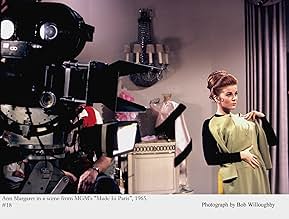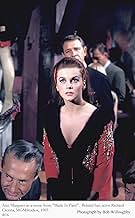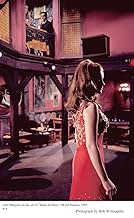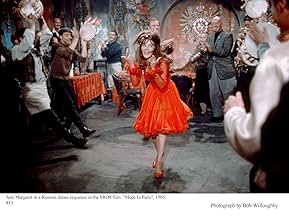An ex model, sales girl and assistant buyer for an NYC dress store lets her hair down when sent to Paris as fashion buyer.An ex model, sales girl and assistant buyer for an NYC dress store lets her hair down when sent to Paris as fashion buyer.An ex model, sales girl and assistant buyer for an NYC dress store lets her hair down when sent to Paris as fashion buyer.
- Awards
- 3 nominations total
Mathilda Calnan
- Cecile
- (as Matilda Calnan)
Michèle Montau
- Elise
- (as Michele Montau)
Count Basie and His Orchestra
- Count Basie and His Orchestra
- (as Count Basie and His Octet)
Mongo Santamaria
- Mongo Santamaria
- (as Mongo Santamaria and His Band)
Leon Alton
- Passerby
- (uncredited)
Don Anderson
- Nightclub Patron
- (uncredited)
Robert Banas
- Dance Partner
- (uncredited)
Majel Barrett
- Mrs. David Prentiss
- (uncredited)
- Director
- Writer
- All cast & crew
- Production, box office & more at IMDbPro
Featured reviews
One of the series of mediocre films that saw Ann-Margret's film career stagnate until 'Carnal Knowledge', 'Made In Paris' looks great, has a decent cast and should be at the very least a harmless timewaster. But it's not even that.
What really sinks it is (as other reviews here have noted) how badly written Ann-Margret's character is, going from prim and naive to a wildcat with no rhyme or reason.
I think this is because the film was trying to have its cake and eat it too in trying to represent both the more permissive culture that was developing in mid-1960s America (even though this is mainly set in Paris), while dealing with the restrictions of the conservative Hays Code, then in its dying days. Unfortunately, the script and direction aren't good enough to overcome this contradiction and the film is a largely dreary mess.
Ann-Margret is largely sunk by the horribly-written character she's saddled with. But she does display her skills during a fun dance number and provides some entertainment when briefly showing her 'wild side'.
Of the rest of the cast, Crenna comes off best with a role that you wish had been more substantial. Everett is dull and Adams is wasted in a nothing role that is even more poorly-scripted than Ann-Margret's is.
Only for die-hard Ann-Margret fans.
What really sinks it is (as other reviews here have noted) how badly written Ann-Margret's character is, going from prim and naive to a wildcat with no rhyme or reason.
I think this is because the film was trying to have its cake and eat it too in trying to represent both the more permissive culture that was developing in mid-1960s America (even though this is mainly set in Paris), while dealing with the restrictions of the conservative Hays Code, then in its dying days. Unfortunately, the script and direction aren't good enough to overcome this contradiction and the film is a largely dreary mess.
Ann-Margret is largely sunk by the horribly-written character she's saddled with. But she does display her skills during a fun dance number and provides some entertainment when briefly showing her 'wild side'.
Of the rest of the cast, Crenna comes off best with a role that you wish had been more substantial. Everett is dull and Adams is wasted in a nothing role that is even more poorly-scripted than Ann-Margret's is.
Only for die-hard Ann-Margret fans.
Beautiful fashion model, salesgirl and assistant buyer Ann-Margret (as Maggie Scott) dates handsome boss' son Chad Everett (as Ted Barclay). When it's time to make out on the sofa, Ann-Margret hits Mr. Everett violently on the head with an "Objet d'art". Everett survives, but with a bandaged head. After the credits, Ann-Margret learns she is being transferred to Paris, where she'll work as a fashion consultant. It's a glamorous and exciting job. Ann-Margret is courted by famous fashion designer Louis Jourdan (as Marc Fontaine) and playboy reporter Richard Crenna (as Herb Stone). Everett also goes to Paris, probably because he regrets asking Mr. Crenna to look after Ann-Margret. Co-worker Edie Adams (as Irene Chase) tries to explain Mr. Jourdan needs sexual satisfaction, but Ann-Margret doesn't seem to understand...
Ann-Margret is an amazing beautiful woman, and director Boris Sagal provides opportunities to see her underclothing. Dressing and undressing scenes are a highlight of "Made in Paris". One standout moment has the leading lady flashing a sexy glimpse of upper thighs while getting up and going to do something impossible to remember unless you're not looking up her short nightie. You could almost see France, but all of this story was done in the US. Of course, you see nothing, but it's Ann-Margret. The actual story is incredibly dull. There is a dreadful "fashion show" segment with stuff Mr. Jourdan's character admits no woman is going to wear. Ann-Margret has a lively dance segment, but this film otherwise wastes its star. The question, "Will her virginity remain intact until just after the closing credits?" is answered.
*** Made in Paris (1966-02-09) Boris Sagal ~ Ann-Margret, Chad Everett, Louis Jourdan, Richard Crenna
Ann-Margret is an amazing beautiful woman, and director Boris Sagal provides opportunities to see her underclothing. Dressing and undressing scenes are a highlight of "Made in Paris". One standout moment has the leading lady flashing a sexy glimpse of upper thighs while getting up and going to do something impossible to remember unless you're not looking up her short nightie. You could almost see France, but all of this story was done in the US. Of course, you see nothing, but it's Ann-Margret. The actual story is incredibly dull. There is a dreadful "fashion show" segment with stuff Mr. Jourdan's character admits no woman is going to wear. Ann-Margret has a lively dance segment, but this film otherwise wastes its star. The question, "Will her virginity remain intact until just after the closing credits?" is answered.
*** Made in Paris (1966-02-09) Boris Sagal ~ Ann-Margret, Chad Everett, Louis Jourdan, Richard Crenna
TCM ran this tonight, and I had to wander why. There's plenty of talent here, but not in the script or the direction.
Poor Ann-Margret, who was an accomplished dancer - and, of course, a very attractive woman - gets stuck in a role where her only dancing is a very bad knock-off of what made her famous in Bye, Bye Birdie. She plays someone so naive and puritanical that all her sex appeal fails to overcome the impression that she's one frigid, repressed basket case.
The rest of the movie isn't much better. Good to very good actors get stuck in roles that barely have two dimensions.
And don't let the "Paris" in the title fool you. Most of this movie was filmed not just on sets - after all, that was true of An American in Paris as well, and that is a stupendous movie - but uninteresting sets, hotel rooms that may have been left over from MGM's 1939 Ninotchka. The only atmospheric moment is an embarrassment. AM and Louis Jourdain appear on the set used for Gene Kelly and Leslie Caron in AAIP, the great Seine River scene where the two great dancers dance and fall in love. This time, however, that same set is shot without any of the poetry that has immortalized it in AAIP. The song is not great Gershwin, but an forgettable flop. And there is no dancing. Even though AM was a great dancer. Talk about wasting an opportunity! In short, there really is nothing to recommend this movie. Those in it all did better, much better, elsewhere. It's often embarrassing to watch them here.
Skip it.
Poor Ann-Margret, who was an accomplished dancer - and, of course, a very attractive woman - gets stuck in a role where her only dancing is a very bad knock-off of what made her famous in Bye, Bye Birdie. She plays someone so naive and puritanical that all her sex appeal fails to overcome the impression that she's one frigid, repressed basket case.
The rest of the movie isn't much better. Good to very good actors get stuck in roles that barely have two dimensions.
And don't let the "Paris" in the title fool you. Most of this movie was filmed not just on sets - after all, that was true of An American in Paris as well, and that is a stupendous movie - but uninteresting sets, hotel rooms that may have been left over from MGM's 1939 Ninotchka. The only atmospheric moment is an embarrassment. AM and Louis Jourdain appear on the set used for Gene Kelly and Leslie Caron in AAIP, the great Seine River scene where the two great dancers dance and fall in love. This time, however, that same set is shot without any of the poetry that has immortalized it in AAIP. The song is not great Gershwin, but an forgettable flop. And there is no dancing. Even though AM was a great dancer. Talk about wasting an opportunity! In short, there really is nothing to recommend this movie. Those in it all did better, much better, elsewhere. It's often embarrassing to watch them here.
Skip it.
This thing was made in 1966, there were social changes a' coming. Heck, the Beatles and dozens of other Brit bands were here; fashions/makeup and social mores were changing fast. And here is our darling young gorgeous naive Ann Margret in the Gay Paree fashion world, fending off several inexplicably straight men dying to get into her lacy undies. Everyone wearing already dated huge Dairy Queen ice-cream-cone hairdos. An eye-goggling endless fashion shows of amazing, though already dated, 'Paris Fashions' (including a hideous hideous wedding gown at the end of the fashion show). And enough dead skinned animal fur to taint the Seine blood red for a year. Every other gown/coat/pantsuit was festooned with fur. Everyone smoking like MAD (and all that fur and expensive clothes worn in nightclubs so thick with nicotine you could hardly see them). Lots of I'm-not-that-kind-of-girl slap and tickle, lots of groovy and not dancing, some OK music of the time - this was made for ladies like my aunt, about 40, and still in love with Elvis years after he peaked. Long gloves, lots of up-do hair, amazing colors, exquisite set decorations (her hotel room - to. die. for.) Just watch this silly dated thing for the eye candy. It plays, and sounds, exactly like something Doris Day would have starred in (she turned it down, wisely, being a bit long in the tooth to play a beautiful young naive virgin being solicited by the three straight men in all of the fashion world.). A lovely Sunday afternoon time-filler. Not good, but not horrible.
An American fashion-buyer is sent to Paris on assignment and immediately gets on the wrong side of a major French designer. Soon though, she almost inadvertently manages to charm him, as well as two other men. What is Ann-Margret doing to drive all these eligible bachelors crazy? As far as we in the audience can see: nothing. Yes, she gets to dance a little and sing a pretty ditty on the docks, but the character is haphazardly written. One minute she's a firebrand, the next she's icy, almost frigid. Judging from her teasing and emotional schizophrenia, it's unlikely that suave Louis Jourdan would even give her the time of day. There's a funny gay-misunderstanding gag involving Richard Crenna (who is a lot more appealing than he's supposed to be), however this is one of A-M's weakest starring vehicles of the 1960s. *1/2 from ****
Did you know
- TriviaAnn-Margret got to keep whatever she wanted of the wardrobe created for her by Helen Rose as part of her contract to do the movie.
- GoofsGlass of water appears and disappears during Paris bedroom scene.
- Quotes
Ted Barclay: That was sent to Lilly LaRue for her strip tease act at the Body Shop.
- ConnectionsFeatured in Made in Paris (1966)
- How long is Made in Paris?Powered by Alexa
Details
- Release date
- Country of origin
- Languages
- Also known as
- Hecho en París
- Filming locations
- Production companies
- See more company credits at IMDbPro
- Runtime1 hour 43 minutes
- Aspect ratio
- 2.35 : 1
Contribute to this page
Suggest an edit or add missing content




































